Inhibition of Autophagy Increases Cell Death in HeLa Cells through Usnic Acid Isolated from Lichens
Abstract
1. Introduction
2. Results and Discussion
2.1. Isolation and Characterization of Lichens for Cytotoxic Activities
2.2. Chemical Composition of UC2A
2.3. Purification and Identification of UA from UC2A Extract
2.3.1. Thin Layer Chromatography (TLC)
2.3.2. GCMS
2.3.3. FTIR
2.4. Usnic Acid (UA) Isolated from UC2A Extract Shows Concentration-Dependent Cytotoxicity against Cancer Cell Lines
2.5. Inhibition of Autophagy Increases the Cytotoxicity of UA against HeLa Cells
2.6. Autophagy Inhibition Increases ROS Generation and Changes the Membrane Potential of UA-Treated Hela Cells
2.7. Autophagy Inhibition Increases Apoptosis in UA-treated HeLa Cells by Increasing Caspase 3/7 Activity
3. Materials and Methods
3.1. Collection and Identification of Lichens
3.2. Cell Line and Culture Conditions
3.3. Preparation of the Lichen Extracts and Screening of the Extracts for Their Cytotoxic Activities in HeLa and MCF Cell Lines
3.4. Screening of Selected Extracts for their Cytotoxic Potential in the Presence of Autophagy Inhibitors
3.5. Gas Chromatography Mass Spectroscopy (GCMS) Studies for Detection of Cytotoxic Metabolites in Lichen Extracts
3.6. Purification and Identification of UA from U. cornuta Acetone Extract (UC2A)
3.6.1. Thin Layer Chromatography (TLC)
3.6.2. GCMS and FTIR Analysis
3.7. Confirmation of Autophagy Inhibition and Change in Mitochondrial Potential using Mitotracker Red (MitoxRed) and Monodansyl Cadaverine (MDC) Staining
3.8. In Vitro Cytotoxicity of UA in Human Cancer Cell Lines and Effect of Autophagy Inhibition on the Cytotoxic Effect of UA on HeLa Cells
3.9. PI Live/Dead Assay
3.10. Dichloro-Dihydro-Fluorescein Diacetate (DCFH-DA) Assay
3.11. Lipid Peroxidation and Reduced Glutathione (GSH) Assay
3.12. Surface Potential of the Cells
3.13. Caspase 3/7 Assay for Confirmation of Apoptosis in the Presence of an Autophagy Inhibitor
3.14. Statistical Analysis
4. Conclusions
Supplementary Materials
Author Contributions
Funding
Data Availability Statement
Acknowledgments
Conflicts of Interest
References
- Mishra, R. An epidemiological study of cervical and breast screening in India: District-level analysis. BMC Women’s Health 2020, 20, 1–15. [Google Scholar] [CrossRef]
- Liu, M.M.; Ma, R.H.; Ni, Z.J.; Thakur, K.; Cespedes-Acuña, C.L.; Jiang, L.; Wei, Z.J. Apigenin 7-O-glucoside promotes cell apoptosis through the PTEN/PI3K/AKT pathway and inhibits cell migration in cervical cancer Hela cells. Food Chem. Toxicol. 2020, 146, 111843. [Google Scholar] [CrossRef] [PubMed]
- Assad, B.M.; Savi, D.C.; Biscaia, S.M.; Mayrhofer, B.F.; Iantas, J.; Mews, M.; de Oliveira, J.C.; Trindade, E.S.; Glienke, C. Endophytic actinobacteria of Hymenachne amplexicaulis from the Brazilian Pantanal wetland produce compounds with antibacterial and antitumor activities. Microbiol. Res. 2021, 248, 126768. [Google Scholar] [CrossRef] [PubMed]
- Homero, U.; Tortella, G.; Sandoval, E.; Cuozzo, S.A. Extracellular Polymeric Substances (EPS) produced by Streptomyces sp. biofilms: Chemical composition and anticancer properties. Microbiol. Res. 2021, 253, 126877. [Google Scholar] [CrossRef] [PubMed]
- Felczykowska, A.; Pastuszak-Skrzypczak, A.; Pawlik, A.; Bogucka, K.; Herman-Antosiewicz, A.; Guzow-Krzemińska, B. Antibacterial and anticancer activities of acetone extracts from in vitro cultured lichen-forming fungi. BMC Comp. Alt. Med. 2017, 17, 300. [Google Scholar] [CrossRef]
- Hei, Y.; Zhang, H.; Tan, N.; Zhou, Y.; Wei, X.; Hu, C.; Liu, Y.; Wang, L.; Qi, J.; Gao, J.M. Antimicrobial activity and biosynthetic potential of cultivable actinomycetes associated with Lichen symbiosis from Qinghai-Tibet Plateau. Microbiol. Res. 2021, 244, 126652. [Google Scholar] [CrossRef]
- Kosanić, M.; Manojlović, N.; Janković, S.; Stanojković, T.; Ranković, B. Evernia prunastri and Pseudoevernia furfuraceae lichens and their major metabolites as antioxidant, antimicrobial and anticancer agents. Food Chem. Toxicol. 2013, 53, 112–118. [Google Scholar] [CrossRef]
- Lagarde, A.; Jargeat, P.; Roy, M.; Girardot, M.; Imbert, C.; Millot, M.; Mambu, L. Fungal communities associated with Evernia prunastri, Ramalina fastigiata and Pleurosticta acetabulum: Three epiphytic lichens potentially active against Candida biofilms. Microbiol. Res. 2018, 211, 1–12. [Google Scholar] [CrossRef]
- Upreti, D.K.; Divakar, P.K.; Nayaka, S. Commercial and ethnic use of lichens in India. Econ. Bot. 2005, 59, 269–273. [Google Scholar] [CrossRef]
- Nayaka, S.; Upreti, D.K. Status of lichen diversity in Western Ghats, India. Sahyadri E-News West. Ghats Biodiverstity Inf. Syst. 2005, 16, 1–28. [Google Scholar]
- Balaji, P.; Hariharan, G.N. Diversity of Macrolichens in Bolampatti II Forest Range (Siruvani Hills), Western Ghats, Tamil Nadu, India. Int. Sch. Res. Not. 2013, 2013, 124020. [Google Scholar] [CrossRef]
- Aravind, S.R.; Sreelekha, T.T.; Kumar, B.D.; Kumar, S.N.; Mohandas, C. Characterization of three depside compounds from a Western Ghat lichen Parmelia erumpens Kurok with special reference to antimicrobial and anticancer activity. RSC Adv. 2014, 4, 34632–34643. [Google Scholar] [CrossRef]
- Machado, N.M.; de Rezende, A.A.A.; Nepomuceno, J.C.; Tavares, D.C.; Cunha, W.R.; Spanó, M.A. Evaluation of mutagenic, recombinogenic and carcinogenic potential of (+)-usnic acid in somatic cells of Drosophila melanogaster. Food Chem. Toxicol. 2016, 96, 226–233. [Google Scholar] [CrossRef] [PubMed]
- Kumari, M.; Kamat, S.; Jayabaskaran, C. Usnic acid induced changes in biomolecules and their association with apoptosis in squamous carcinoma (A-431) cells: A flow cytometry, FTIR and DLS spectroscopic study. Spectrochim. Acta A Mol. Biomol. Spectrosc. 2022, 274, 121098. [Google Scholar] [CrossRef] [PubMed]
- Tompkins, K.D.; Thorburn, A. Focus: Death: Regulation of apoptosis by autophagy to enhance cancer therapy. Yale J. Biol. Med. 2019, 92, 707. [Google Scholar] [PubMed]
- White, E.; DiPaola, R.S. The double-edged sword of autophagy modulation in cancer. Clin. Cancer Res. 2009, 15, 5308–5316. [Google Scholar] [CrossRef]
- Wang, N.; Feng, Y. Elaborating the role of natural products-induced autophagy in cancer treatment: Achievements and artifacts in the state of the art. BioMed Res. Int. 2015, 2015, 934207. [Google Scholar] [CrossRef]
- Deng, S.; Shanmugam, M.K.; Kumar, A.P.; Yap, C.T.; Sethi, G.; Bishayee, A. Targeting autophagy using natural compounds for cancer prevention and therapy. Cancer 2019, 125, 1228–1246. [Google Scholar] [CrossRef]
- Chen, S.; Dobrovolsky, V.N.; Liu, F.; Wu, Y.; Zhang, Z.; Mei, N.; Guo, L. The role of autophagy in usnic acid-induced toxicity in hepatic cells. Toxicol. Sci. 2014, 142, 33–44. [Google Scholar] [CrossRef]
- Yurdacan, B.; Egeli, U.; Eskiler, G.G.; Eryilmaz, I.; Cecener, G.; Tunca, B. The role of usnic acid-induced apoptosis and autophagy in hepatocellular carcinoma. Hum. Experiment. Toxicol. 2019, 38, 201–215. [Google Scholar] [CrossRef]
- Geng, X.; Zhang, X.; Zhou, B.; Zhang, C.; Tu, J.; Chen, X.; Wang, J.; Gao, H.; Qin, G.; Pan, W. Usnic acid induces cycle arrest, apoptosis, and autophagy in gastric cancer cells in vitro and in vivo. Med. Sci. Monit. 2018, 24, 556. [Google Scholar] [CrossRef] [PubMed]
- Solárová, Z.; Liskova, A.; Samec, M.; Kubatka, P.; Büsselberg, D.; Solár, P. Anticancer potential of lichens’ secondary metabolites. Biomolecules 2020, 10, 87. [Google Scholar] [CrossRef] [PubMed]
- Dar, T.U.H.; Dar, S.A.; Islam, S.U.; Mangral, Z.A.; Dar, R.; Singh, B.P.; Verma, P.; Haque, S. May. Lichens as a repository of bioactive compounds: An open window for green therapy against diverse cancers. Semin. Cancer Biol. 2021, 36, 1120–1137. [Google Scholar] [CrossRef]
- Popovici, V.; Bucur, L.A.; Schröder, V.; Gherghel, D.; Mihai, C.T.; Caraiane, A.; Badea, F.C.; Vochița, G.; Badea, V. Evaluation of the cytotoxic activity of the Usnea barbata (L.) FH Wigg dry extract. Molecules 2020, 25, 1865. [Google Scholar] [CrossRef]
- Ozturk, S.; Erkisa, M.; Oran, S.; Ulukaya, E.; Celikler, S.; Ari, F. Lichens exerts an anti-proliferative effect on human breast and lung cancer cells through induction of apoptosis. Drug Chem. Toxicol. 2021, 44, 259–267. [Google Scholar] [CrossRef]
- Zugic, A.; Jeremic, I.; Isakovic, A.; Arsic, I.; Savic, S.; Tadic, V. Evaluation of anticancer and antioxidant activity of a commercially available CO2 supercritical extract of old man’s beard (Usnea barbata). PLoS ONE 2016, 11, e0146342. [Google Scholar] [CrossRef]
- Nugraha, A.S.; Laksono, T.A.; Firli, L.N.; Putri, C.P.Z.S.; Pratoko, D.K.; Zulfikar, Z.; Untari, L.F.; Wongso, H.; Lambert, J.M.; Dillon, C.T.; et al. Anti-Cancer Evaluation of Depsides Isolated from Indonesian Folious Lichens: Physcia millegrana, Parmelia dilatata and Parmelia aurulenta. Biomolecules 2020, 10, 1420. [Google Scholar] [CrossRef] [PubMed]
- Available online: https://pubchem.ncbi.nlm.nih.gov/compound/Apovincamine#section=Biological-Test-Result (accessed on 14 January 2023).
- Nikolić, V.; Stanković, M.; Nikolić, L.; Nikolić, G.; Ilić-Stojanović, S.; Popsavin, M.; Zlatković, S.; Kundaković, T. Inclusion complexes with cyclodextrin and usnic acid. J. Incl. Phenom. Macrocycl. Chem. 2013, 76, 173. [Google Scholar] [CrossRef]
- Karabacak, R.B.; Tay, T.; Kıvanç, M. Preparation of novel antimicrobial polymer colloids based on (+)-usnic acid and poly (vinylbenzyl chloride). React. Funct. Polym. 2014, 83, 7–13. [Google Scholar] [CrossRef]
- Zhang, A.; He, W.; Shi, H.; Huang, X.; Ji, G. Natural compound oblongifolin C inhibits autophagic flux, and induces apoptosis and mitochondrial dysfunction in human cholangiocarcinoma QBC939 cells. Mol. Med. Rep. 2016, 14, 3179–3183. [Google Scholar] [CrossRef] [PubMed]
- Kamat, S.; Kumari, M.; Jayabaskaran, C. Visualizing the anti-cancer effects of chrysin nanoparticles by flow cytometry, microscopy and Fourier transform infrared spectroscopy. In Colloidal Nanoparticles for Biomedical Applications XVII; SPIE BiOS: Bellingham, WA, USA, 2022; Volume 11977, pp. 40–52. [Google Scholar] [CrossRef]
- Marino, G.; Niso-Santano, M.; Baehrecke, E.H.; Kroemer, G. Self-consumption: The interplay of autophagy and apoptosis. Nat. Rev. Mol. Cell Biol. 2014, 15, 81–94. [Google Scholar] [CrossRef] [PubMed]
- Xie, Q.; Chen, Y.; Tan, H.; Liu, B.; Zheng, L.L.; Mu, Y. Targeting autophagy with natural compounds in cancer: A renewed perspective from molecular mechanisms to targeted therapy. Front. Pharmacol. 2021, 12, 748149. [Google Scholar] [CrossRef] [PubMed]
- Poillet-Perez, L.; Despouy, G.; Delage-Mourroux, R.; Boyer-Guittaut, M. Interplay between ROS and autophagy in cancer cells, from tumor initiation to cancer therapy. Redox Biol. 2015, 4, 184–192. [Google Scholar] [CrossRef] [PubMed]
- Perillo, B.; Di Donato, M.; Pezone, A.; Di Zazzo, E.; Giovannelli, P.; Galasso, G.; Castoria, G.; Migliaccio, A. ROS in cancer therapy: The bright side of the moon. Exp. Mol. Med. 2020, 52, 192–203. [Google Scholar] [CrossRef]
- Yun, H.R.; Jo, Y.H.; Kim, J.; Shin, Y.; Kim, S.S.; Choi, T.G. Roles of autophagy in oxidative stress. Int. J. Mol. Sci. 2020, 21, 3289. [Google Scholar] [CrossRef]
- Ortega, A.L.; Mena, S.; Estrela, J.M. Glutathione in cancer cell death. Cancers 2011, 3, 1285–1310. [Google Scholar] [CrossRef]
- Clemente, S.M.; Martínez-Costa, O.H.; Monsalve, M.; Samhan-Arias, A.K. Targeting lipid peroxidation for cancer treatment. Molecules 2020, 25, 5144. [Google Scholar] [CrossRef]
- Aggarwal, V.; Tuli, H.S.; Varol, A.; Thakral, F.; Yerer, M.B.; Sak, K.; Varol, M.; Jain, A.; Khan, M.; Sethi, G. Role of reactive oxygen species in cancer progression: Molecular mechanisms and recent advancements. Biomolecules 2019, 9, 735. [Google Scholar] [CrossRef]
- Zhang, Y.; Yang, M.; Portney, N.G.; Cui, D.; Budak, G.; Ozbay, E.; Ozkan, M.; Ozkan, C.S. Zeta potential: A surface electrical characteristic to probe the interaction of nanoparticles with normal and cancer human breast epithelial cells. Biomed. Microdevices 2008, 10, 321–328. [Google Scholar] [CrossRef]
- Kazantsev, S.O.; Fomenko, A.N.; Korovin, M.S. Zeta potential change of neuro-2a tumor cells after exposure to alumina nanoparticles. In AIP Conference Proceedings; AIP Publishing LLC: Melville, NY, USA, 2016; Volume 1760, p. 020025. [Google Scholar] [CrossRef]
- Taritla, S.; Kumari, M.; Kamat, S.; Bhat, S.G.; Jayabaskaran, C. Optimization of PhysicoChemical Parameters for Production of Cytotoxic Secondary Metabolites and Apoptosis Induction Activities in the Culture Extract of a Marine Algal–Derived Endophytic Fungus Aspergillus sp. Front. Pharmacol. 2021, 12, 542891. [Google Scholar] [CrossRef]
- Rahman, M.; Hannan, M.A.; Dash, R.; Rahman, M.D.; Islam, R.; Uddin, M.J.; Sohag, A.A.M.; Rhim, H. Phytochemicals as a complement to cancer chemotherapy: Pharmacological modulation of autophagy-apoptosis pathway. Front. Pharmacol. 2021, 12, 718. [Google Scholar] [CrossRef] [PubMed]
- Bhattacharjee, A.; Hasanain, M.; Kathuria, M.; Singh, A.; Datta, D.; Sarkar, J.; Mitra, K. Ormeloxifene-induced unfolded protein response contributes to autophagy-associated apoptosis via disruption of Akt/mTOR and activation of JNK. Sci. Rep. 2018, 8, 2303. [Google Scholar] [CrossRef] [PubMed]
- Hung, J.Y.; Hsu, Y.L.; Li, C.T.; Ko, Y.C.; Ni, W.C.; Huang, M.S.; Kuo, P.L. 6-Shogaol, an active constituent of dietary ginger, induces autophagy by inhibiting the AKT/mTOR pathway in human non-small cell lung cancer A549 cells. J. Agric. Food Chem. 2009, 57, 9809–9816. [Google Scholar] [CrossRef] [PubMed]
- Kumari, M.; Taritla, S.; Sharma, A.; Jayabaskaran, C. Antiproliferative and antioxidative bioactive compounds in extracts of marine-derived endophytic fungus Talaromyces purpureogenus. Front. Microbiol. 2018, 9, 1777. [Google Scholar] [CrossRef] [PubMed]
- Kamat, S.; Kumari, M.; Taritla, S.; Jayabaskaran, C. Endophytic fungi of marine alga from Konkan coast, India—A rich source of bioactive material. Front. Marine Sci. 2020, 7, 31. [Google Scholar] [CrossRef]
- Patra, S.; Panda, P.K.; Naik, P.P.; Panigrahi, D.P.; Praharaj, P.P.; Bhol, C.S.; Mahapatra, K.K.; Padhi, P.; Jena, M.; Patil, S.; et al. Terminalia bellirica extract induces anticancer activity through modulation of apoptosis and autophagy in oral squamous cell carcinoma. Food Chem. Toxicol. 2020, 136, 111073. [Google Scholar] [CrossRef]
- Sajna, K.V.; Kamat, S.; Jayabaskaran, C. Antiproliferative role of secondary metabolites from Aspergillus unguis AG 1.1 (G) isolated from marine macroalgae Enteromorpha sp. by inducing intracellular ROS production and mitochondrial membrane potential loss leading to apoptosis. Front. Marine Sci. 2020, 7, 543523. [Google Scholar] [CrossRef]
- Kamat, S.; Kumari, M.; Sajna, K.V.; Jayabaskaran, C. Endophytic fungus, Chaetomium globosum, associated with marine green alga, a new source of Chrysin. Scient. Rep. 2020, 10, 18726. [Google Scholar] [CrossRef]
- Yu, J.; Chen, C.; Xu, T.; Yan, M.; Xue, B.; Wang, Y.; Liu, C.; Zhong, T.; Wang, Z.; Meng, X.; et al. Pseudolaric acid B activates autophagy in MCF 7 human breast cancer cells to prevent cell death. Oncol. Lett. 2016, 11, 1731–1737. [Google Scholar] [CrossRef]
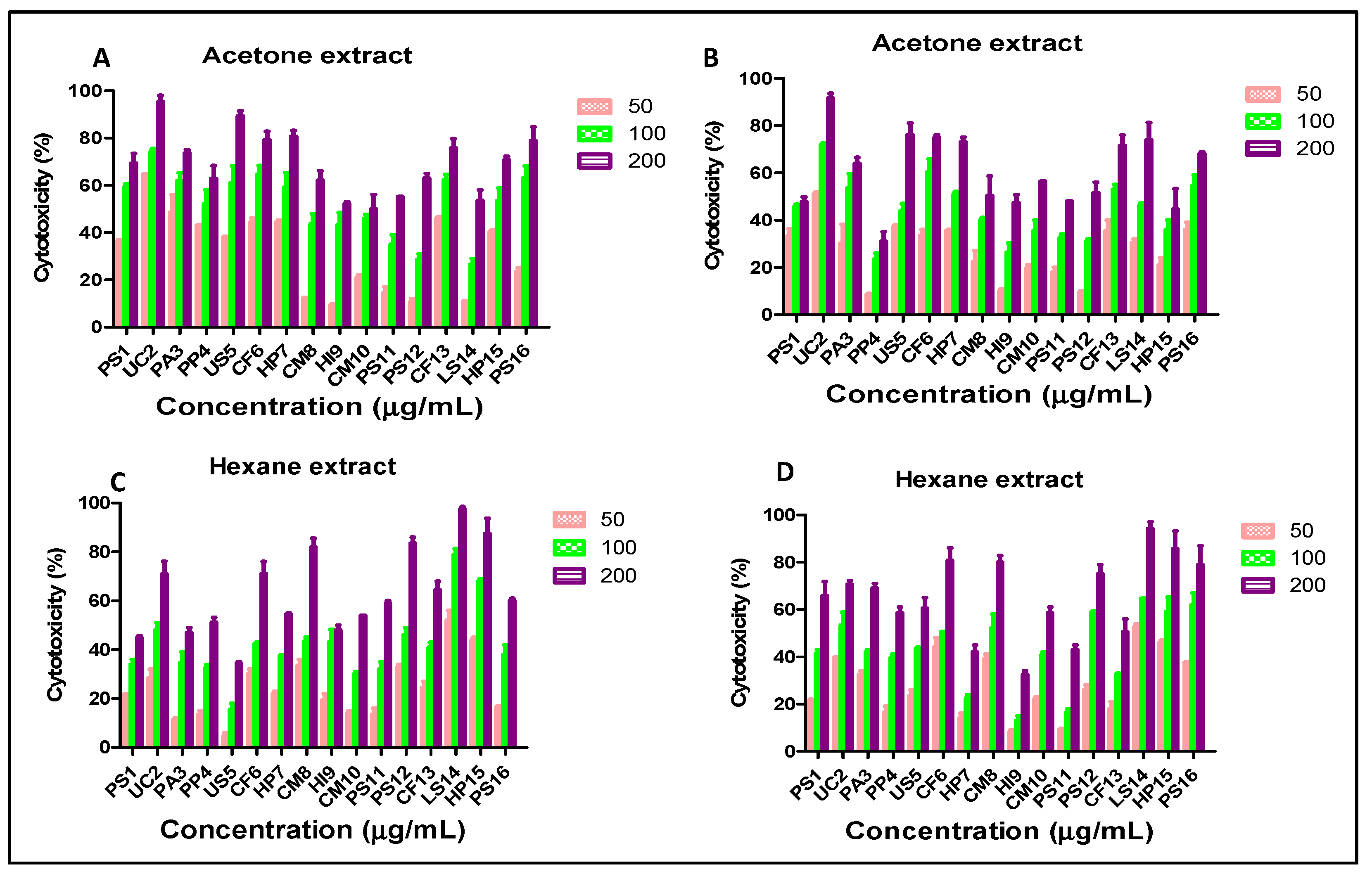
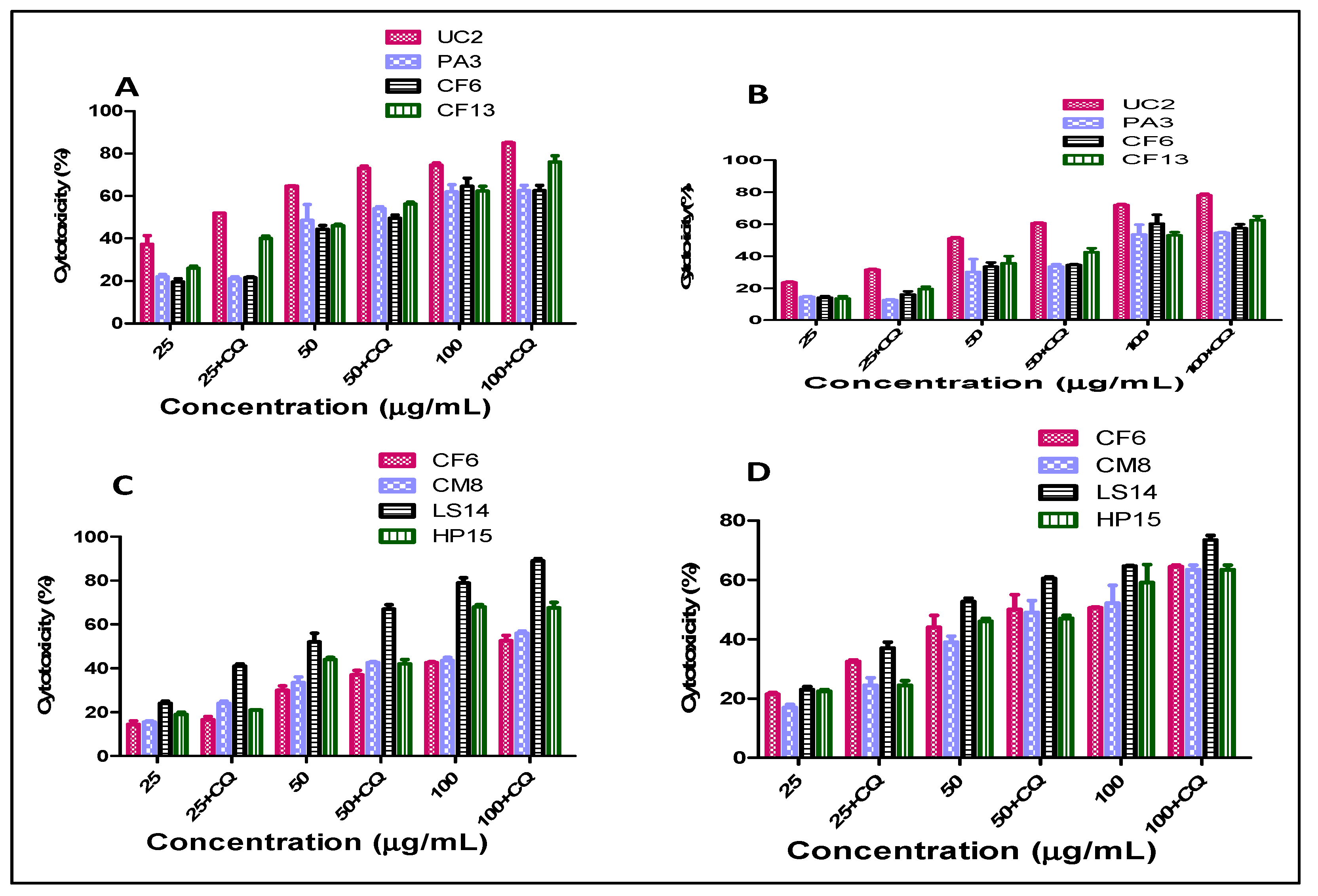
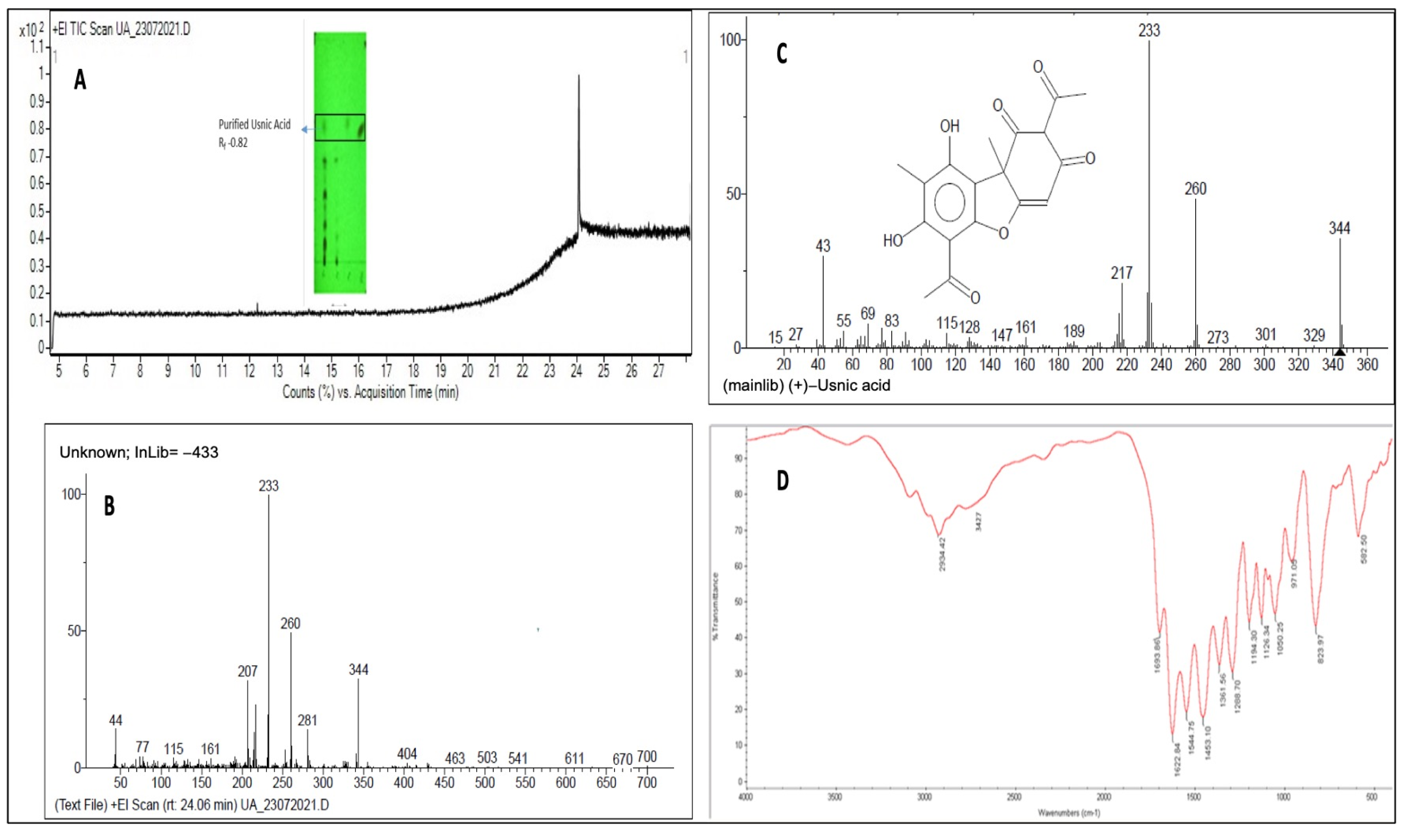
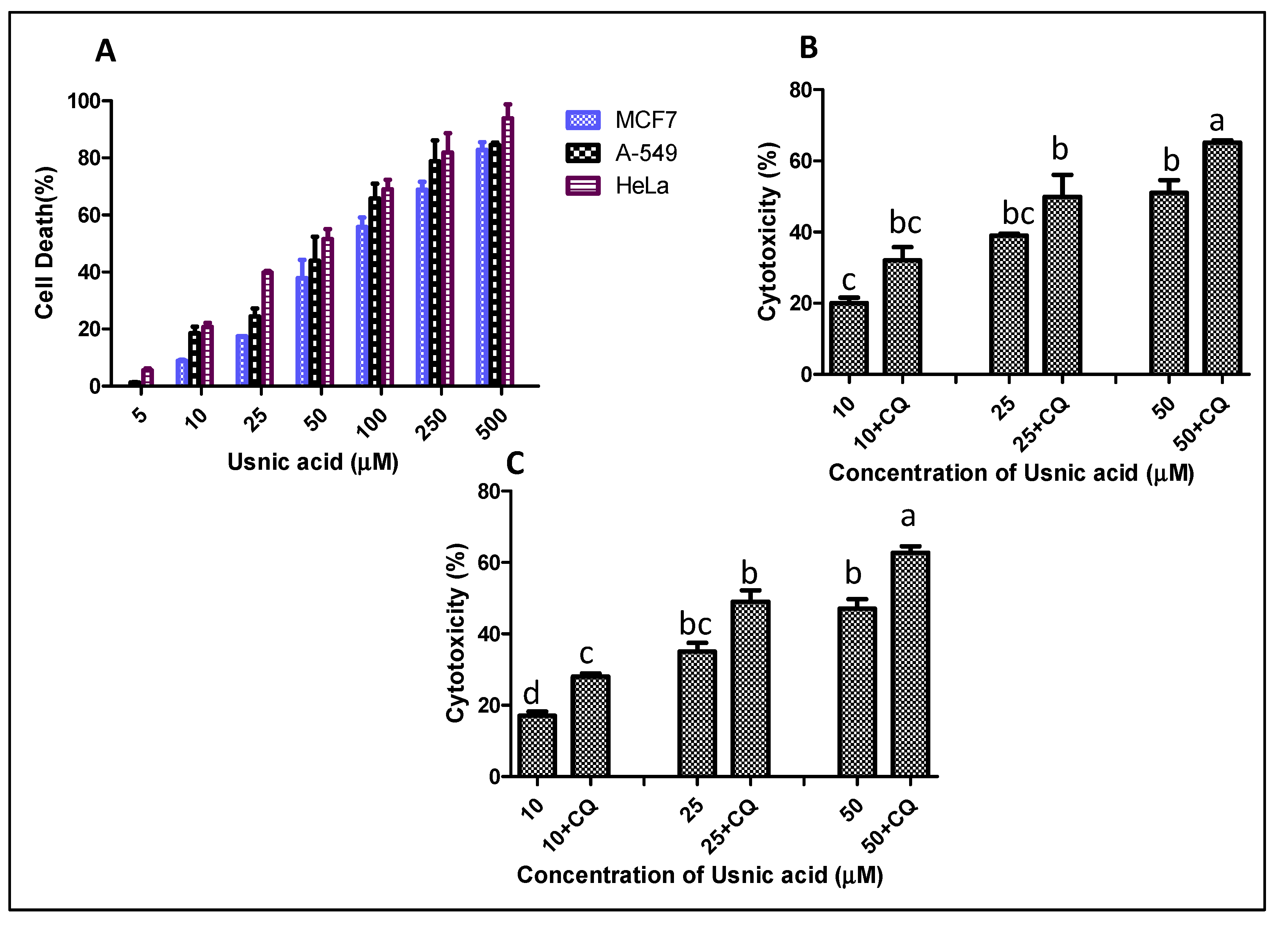
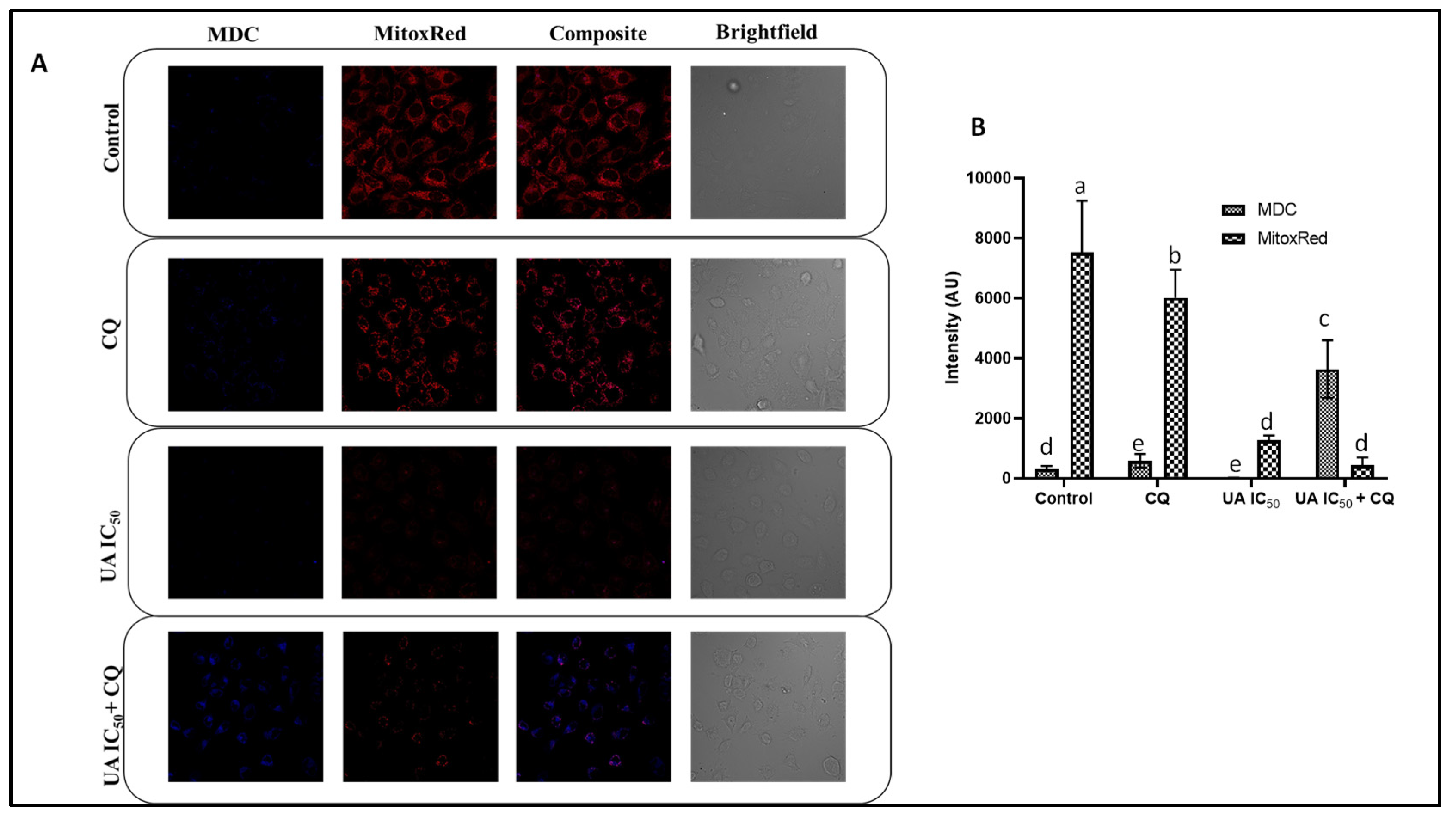
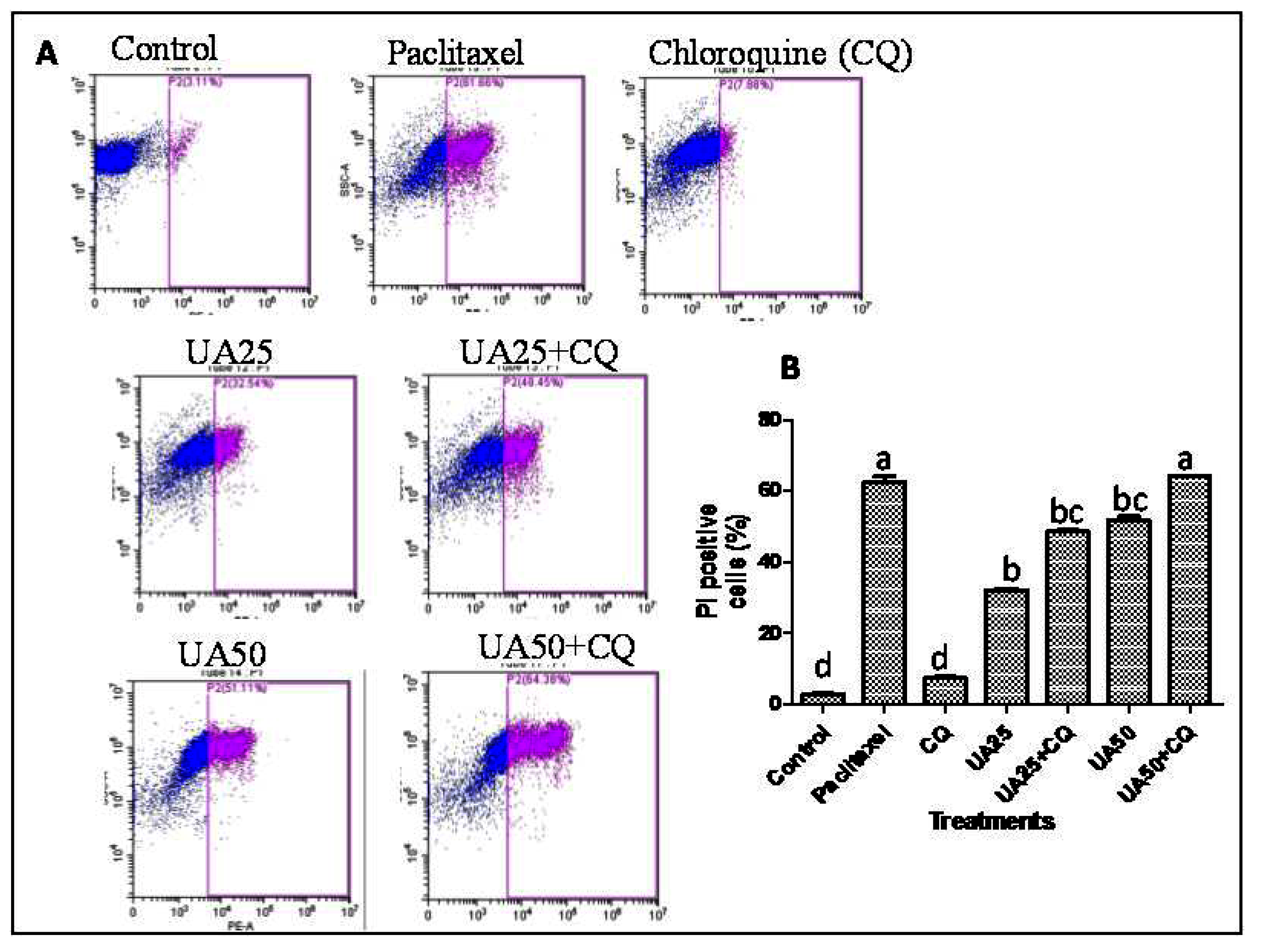
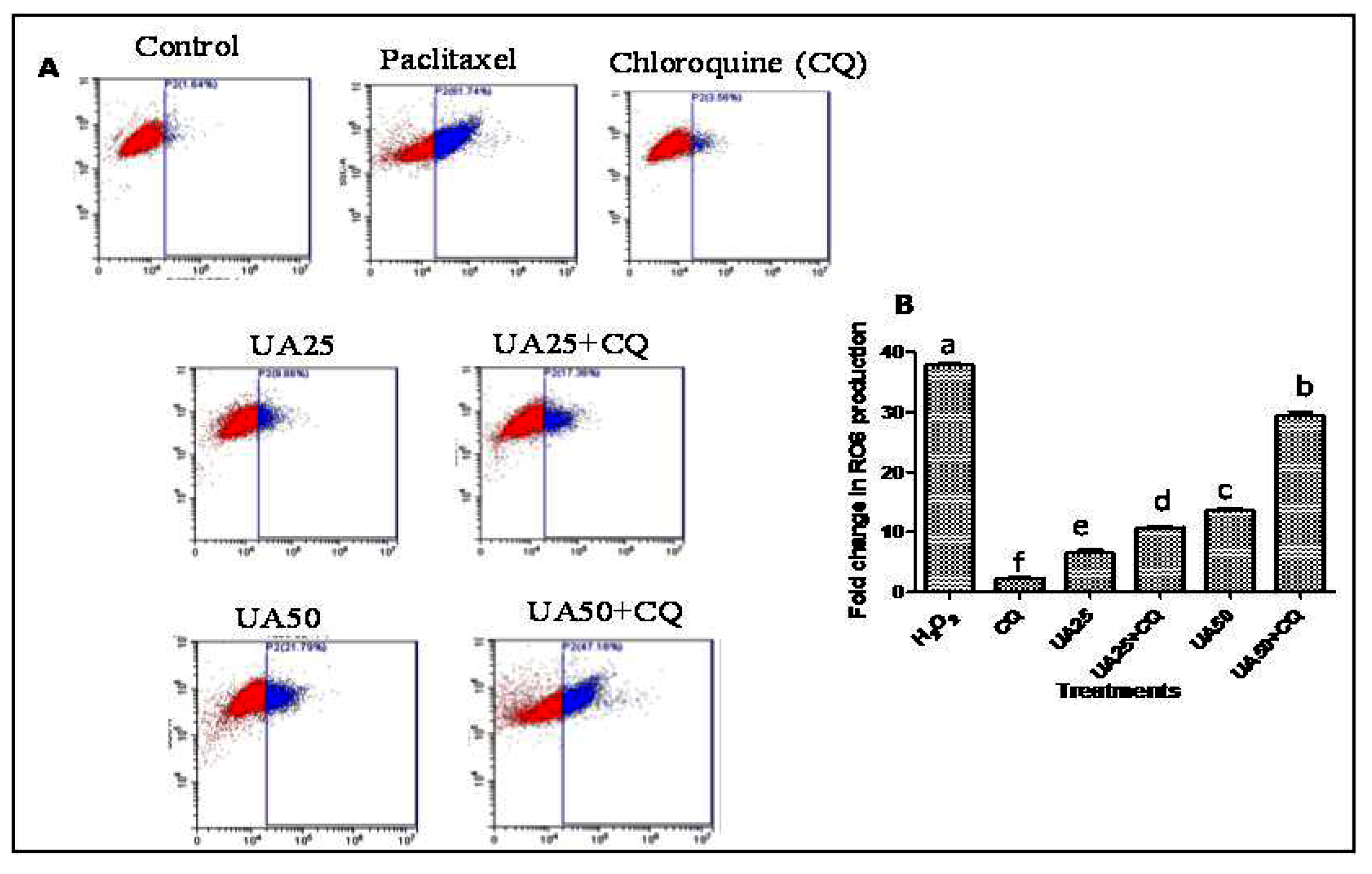
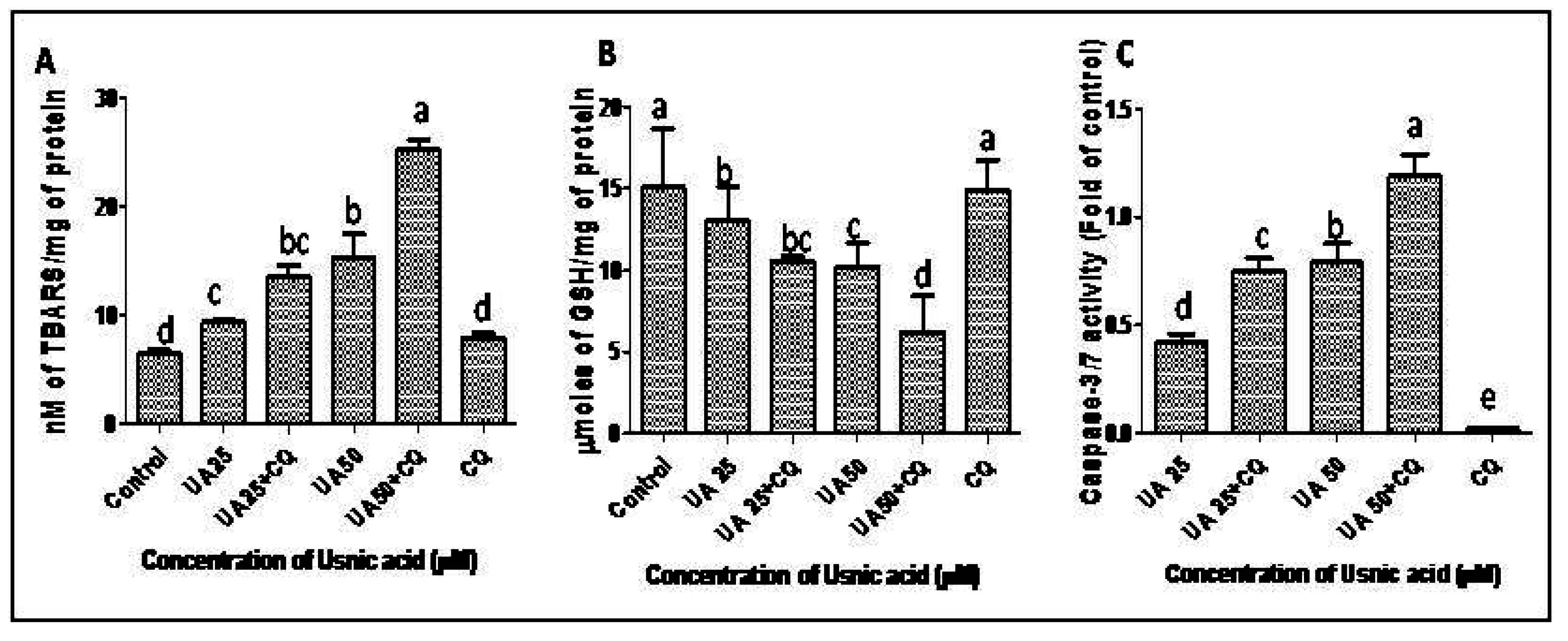
| S. No | Lichen Extract | Acetone Extract IC50 (µg/mL) | Hexane Extract IC50 (µg/mL) | ||
|---|---|---|---|---|---|
| HeLa | MCF7 | HeLa | MCF7 | ||
| 1. | PS1 | 99.28 ± 3 | 98.80 ± 8 | >200 | 174.8 ± 6 |
| 2. | UC2 | 38.2 ± 1.25 | 41.7 ± 2 | 96.8 ± 11 | 167.2 ± 7 |
| 3. | PA3 | 79.12 ± 8 | 93.5 ± 5 | >200 | 170.3 ± 8 |
| 4. | PP4 | 76.87 ± 4 | >200 | >200 | 189.3 ± 9 |
| 5. | US5 | 73.2 ± 6 | 115.02 ± 6 | >200 | 183.09 ± 5 |
| 6. | CF6 | 75.31 ± 1 | 69.77 ± 9 | 79.05 ± 8 | 71.4 ± 8 |
| 7. | HP7 | 75.45 ± 7 | 71.51 ± 11 | 191 ± 2 | >200 |
| 8. | CM8 | 158.40 ± 13 | >200 | 69.03 ± 7 | 70.04 ± 4 |
| 9. | HI9 | 188.28 ± 17 | >200 | >200 | >200 |
| 10. | CM10 | 173.03 ± 16 | 188.28 ± 19 | 175.7 ± 13 | 189.1 ± 14 |
| 11. | PS11 | 179.75 ± 11 | >200 | 186.3 ± 16 | >200 |
| 12. | PS12 | 115.22 ± 13 | >200 | 86.4 ± 7 | 82.8 ± 9 |
| 13. | CF13 | 53.76 ± 5 | 63.8 ± 8 | 123.1 ± 9 | >200 |
| 14. | LS14 | 169.35 ± 9 | 65.2 ± 2 | 41.1 ± 3 | 53.7 ± 5 |
| 15. | HP15 | 89.22 ± 5 | >200 | 59.09 ± 5 | 58.3 ± 4 |
| 16. | PS16 | 71.88 ± 4 | 111.06 ± 7 | 111.9 ± 6 | 66.2 ± 7 |
| (A) | |||||
|---|---|---|---|---|---|
| S. No | Lichen Extract | Acetone Extract | |||
| HeLa | MCF-7 | ||||
| −CQ | +CQ | −CQ | +CQ | ||
| 1. | UC2 | 38.2 ± 1.25 | 26.01 ± 1 | 41.7 ± 2 | 37.1 ± 2 |
| 2. | PA3 | 79.12 ± 8 | 78.09 ± 6 | 93.5 ± 5 | 92.9 ± 7 |
| 3. | CF6 | 75.31 ± 1 | 77.56 ± 9 | 69.77 ± 9 | 72.7 ± 8 |
| 4. | CF13 | 53.76 ± 5 | 46.9 ± 6 | 63.8 ± 8 | 67.4 ± 9 |
| (B) | |||||
| S. No | Lichen Extract | Hexane Extract | |||
| HeLa | MCF-7 | ||||
| −CQ | +CQ | −CQ | +CQ | ||
| 1. | CF6 | 79.05 ± 8 | 72.3 ± 8 | 71.4 ± 8 | 66.6 ± 8 |
| 2. | CM8 | 69.03 ± 7 | 62.8 ± 7 | 70.04 ± 4 | 66.9 ± 6 |
| 3. | LS14 | 41.1 ± 3 | 34.03 ± 1 | 53.7 ± 5 | 47.4 ± 4 |
| 4. | HP15 | 59.09 ± 5 | 58.9 ± 4 | 58.3 ± 4 | 59 ± 2 |
| S. No | Name of the Compound | Chemical Formula | Retention Time (Rt) | Area | Relative % Peak Area |
|---|---|---|---|---|---|
| 1 | 1,2-Benzenediol, o-(2,3,4-trifluorobenzoyl)-o’-(2,2,3,3,4,4,4-heptafluorobutyryl)- | C17H6F10O4 | 8.758 | 65,830 | 0.07 |
| 2 | Pentasiloxane, dodecamethyl- | C12H36O4Si5 | 8.802 | 75,562 | 0.08 |
| 3 | 3,6,9-Trioxa-2,10-disilaundecane, 2,2,10,10-tetramethyl- | C10H26O3Si2 | 10.315 | 471,048 | 0.5 |
| 4 | Hexane, 3,3-dimethyl | C8H18 | 10.749 | 45,591 | 0.04 |
| 5 | 1,2,3-Trimethyldiaziridine | C4H10N2 | 10.749 | 41,170 | 0.04 |
| 6 | Glycerol, tris(trimethylsilyl) ether | C12H32O3Si3 | 11.098 | 1,216,831 | 1.3 |
| 7 | 3-Penten-2-one, 5,5,5-trimethoxy-, (Z)- | C8H14O4 | 13.43 | 25,375 | 0.02 |
| 8 | Benzoic acid, 2,4-dihydroxy-3,6-dimethyl-, methyl ester | C10H12O4 | 14.068 | 8,253,466 | 8.8 |
| 9 | Trimethyl(2,6 ditert.-butylphenoxy)silane | C17H30OSi | 16.362 | 790,618 | 0.84 |
| 10 | Benzoic acid, 2-hydroxy-4-((2-hydroxy-4-methoxy-3,6-dimethylbenzoyl) oxy)-3,6-dimethyl-, methyl ester | C19H20O7 | 17.18 | 9,126,518 | 9.7 |
| 11 | Pentane, 1-(1-ethoxyethoxy)- | C9H20O2 | 18.149 | 13,449 | 0.01 |
| 12 | L-(-)-Arabitol, pentakis(trimethylsilyl) ether | C20H52O5Si5 | 19.565 | 5,036,488 | 5.3 |
| 13 | 2-Deoxy ribose O,O’,O’’-tris(trimethylsilyl)- | C14H34O4Si3 | 19.72 | 5,745,306 | 6.14 |
| 14 | DL-Glyceraldehyde, tris(trimethylsilyl) ether | C12H30O3Si3 | 19.734 | 3,791,242 | 4.05 |
| 15 | meso-Erythritol, tetrakis(trimethylsilyl) ether | C16H42O4Si4 | 19.964 | 20,462,416 | 21.8 |
| 16 | L-(-)-Arabitol, pentakis(trimethylsilyl) ether | C20H52O5Si5 | 20.12 | 5,937,654 | 6.35 |
| 17 | Adonitol, pentakis(trimethylsilyl) ether | C20H52O5Si5 | 20.174 | 11,992,669 | 12.8 |
| 18 | D-Ribo-Hexitol, 3-deoxy-1,2,4,5,6-pentakis-O-(trimethylsilyl)- | C21H54O5Si5 | 22.039 | 470,230 | 0.5 |
| 19 | Anhydro 5-hydroxy-3-piperonyl-1,2,3,4-oxatriazolium hydroxide | C9H7N3O4 | 22.584 | 24,373 | 0.02 |
| 20 | 9,10-Anthracenedione, 2-methyl-1,6-bis[(trimethylsilyl)oxy]- | C21H26O4Si2 | 23.515 | 240,365 | 0.25 |
| 21 | Benzenamine, 2,6-diethyl- | C10H15N | 23.698 | 39,700 | 0.04 |
| 22 | (+)-Usnic acid | C18H16O7 | 24.358 | 10,990,722 | 11.7 |
| 23 | Hexadecanoic acid, trimethylsilyl ester | C19H40O2Si | 24.842 | 1,843,200 | 1.97 |
| 24 | Apovincamine | C21H24N2O2 | 27.26 | 1,386 | 0.001 |
| 25 | Octadecanoic acid, trimethylsilyl ester | C21H44O2Si | 27.696 | 679,631 | 0.72 |
| 26 | Hexadecanoic acid, 2,3-bis[(trimethylsilyl)oxy]propyl ester | C25H54O4Si2 | 32.355 | 740,045 | 0.79 |
| 27 | 1,4-Benzenedicarboxylic acid, bis(2-ethylhexyl) ester | C24H38O4 | 34.058 | 218,519 | 0.23 |
| 28 | Octadecanoic acid, 2,3-bis[(trimethylsilyl)oxy]propyl ester | C27H58O4Si2 | 34.609 | 5,103,911 | 5.46 |
| 29 | 1-(Bromomethyl)-2,3-bis(4,5-dimethoxy-2-methylphenyl)-2,3-dihydro-4,5-dimethoxy-7-methyl-1H-indene | C31H37BrO6 | 41.231 | 11,108 | 0.011 |
Disclaimer/Publisher’s Note: The statements, opinions and data contained in all publications are solely those of the individual author(s) and contributor(s) and not of MDPI and/or the editor(s). MDPI and/or the editor(s) disclaim responsibility for any injury to people or property resulting from any ideas, methods, instructions or products referred to in the content. |
© 2023 by the authors. Licensee MDPI, Basel, Switzerland. This article is an open access article distributed under the terms and conditions of the Creative Commons Attribution (CC BY) license (https://creativecommons.org/licenses/by/4.0/).
Share and Cite
Kumari, M.; Kamat, S.; Singh, S.K.; Kumar, A.; Jayabaskaran, C. Inhibition of Autophagy Increases Cell Death in HeLa Cells through Usnic Acid Isolated from Lichens. Plants 2023, 12, 519. https://doi.org/10.3390/plants12030519
Kumari M, Kamat S, Singh SK, Kumar A, Jayabaskaran C. Inhibition of Autophagy Increases Cell Death in HeLa Cells through Usnic Acid Isolated from Lichens. Plants. 2023; 12(3):519. https://doi.org/10.3390/plants12030519
Chicago/Turabian StyleKumari, Madhuree, Siya Kamat, Sandeep Kumar Singh, Ajay Kumar, and C. Jayabaskaran. 2023. "Inhibition of Autophagy Increases Cell Death in HeLa Cells through Usnic Acid Isolated from Lichens" Plants 12, no. 3: 519. https://doi.org/10.3390/plants12030519
APA StyleKumari, M., Kamat, S., Singh, S. K., Kumar, A., & Jayabaskaran, C. (2023). Inhibition of Autophagy Increases Cell Death in HeLa Cells through Usnic Acid Isolated from Lichens. Plants, 12(3), 519. https://doi.org/10.3390/plants12030519







